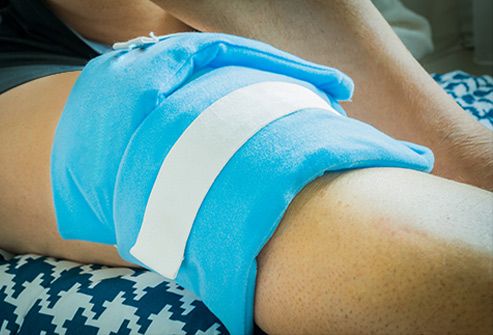| SLIDESHOW |
| Knee Pain Dos and Don'ts |
Your knee needs rest, but not too much. Here's what else can help relieve your pain and what can make it worse. 
Knee Pain Dos and Don’ts

1/16
Do: Rest a Sore Knee
Take a break so your
knee has time to heal. You’ll only need 1 or 2 days of rest to ease minor knee
pain, but severe injuries may keep you off your feet longer. Talk to your
doctor if it doesn’t get better after a few days.

1/16
Don’t: Stay on the Couch Too Long
Exercise builds strong
muscles around your joints, and that helps prevent injuries. Once your knee has
had enough rest, get back out there. Low-impact water workouts or tai chi are
good options. But don’t overdo it or you’ll risk more pain.

1/16
Do: Use RICE
Try the RICE formula to
treat a knee injury:
Rest for a day or two to
heal.
Ice your knee to calm
inflammation.
Compress (wrap) your
joint for support and to stop fluid buildup.
Elevate it on a pillow or
stool to curb swelling.

1/16
Don’t: Risk Slips, Trips, or Falls
Wear shoes with good
tread on them to cut your risk of a slip. Choose low-heeled ones with soft,
rubber soles. Keep your home’s hallways and stairwells well lit, and clear
floors of things you could trip over.

1/16
Do: Use a Cane If You Need One
Feel unsteady? Use
something to steady you as you move around. Choose a sturdy, strong, light cane
with a rubber tip and a handle that’s easy to grasp. Hold it at a 45-degree
angle to be sure it’s the right height. Find one in a color or style you like so
you’ll be more likely to use it.

1/16
Do: Watch Your Weight
Extra pounds add strain
to your knees and raise your risk of painful arthritis and injuries. But even
moderate weight loss can make it better. If you need to drop a few pounds, set
a goal to lose just 5% of your current weight over the next few months.

1/16
Do: Consider Acupuncture
Tiny needles are put
into the skin around your sore joint. Research shows it can ease knee arthritis
pain, though it’s still unclear how. Look for someone who's trained and
experienced. Many states license acupuncturists.

1/16
Don’t: Forget to Stretch
The muscles around your
knees can get tight, and that can lead to painful injuries. Daily stretches can
prevent that and muscle pain. Ask your doctor or physical therapist for easy
moves to help you limber up before you walk or do any other activity.

1/16
Do: Use Heat and Cold
If your knee pain
flares, try hot or cold treatments. Moist heat is better for pain relief than
dry. Soak in a warm bath, or zap a damp washcloth in the microwave. To ease a
swollen knee, press a bag of frozen veggies wrapped in a towel against the
joint.

1/16
Don’t: Sleep in the Wrong Position
This can make your knee
pain worse. Try out different positions, and put a pillow between your knees if
you sleep on your side. Don’t prop up a bent knee on a pillow, though -- that
can make it harder to unbend your leg the next day.

1/16
Do: Try Braces or Sleeves
Support a sore, weak
knee with a brace, sleeve, or tape. Ask a physical therapist to fit you with
one or to tape your knee. A simple sleeve that fits over your knee can offer
short-term pain relief, too. You can find them at the drugstore.

1/16
Don’t: Wear Out Your Knees
You may get knee pain
because you overload your joints. Movements you do over and over again, like go
up and down stairs every day, can jar and wear down your knees. But don’t sit
for long periods, either. That puts extra pressure between your knee and leg
bone that can cause pain.

1/16
Do: Support Your Arches
Choose shoes that
support your arches, or get slip-in inserts at your local drugstore. If those
don’t work, you can ask your doctor about custom supports. But those can be
expensive and don’t always work better than the ones available over the
counter.

1/16
Don’t: Keep Wearing the Same Old Shoes
Shoes can stretch and
wear out after a while. Don’t keep wearing your favorite pair after their
support and tread have worn out. You may find that new shoes that support your
feet and ankles well ease your knee pain.

1/16
Do: Talk to Your Doctor
You don’t have to deal
with knee pain alone. Your doctor might prescribe medication or give you a
steroid shot to help. She also might talk with you about surgery to replace
worn joints or ligaments.
This tool does not provide medical advice.
|
মন্তব্যসমূহ
একটি মন্তব্য পোস্ট করুন